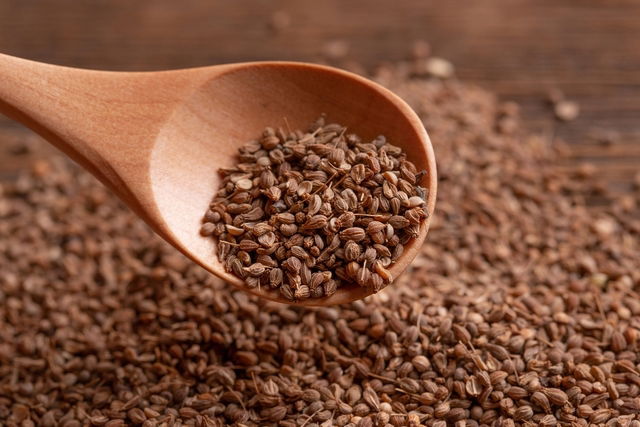Anise is a medicinal plant that is rich in flavonoids, malic acid and caffeic acid. These are bioactive compounds with digestive, laxative, carminative and spasmolytic properties that can help to relieve gas, constipation, abdominal cramping and indigestion.
Scientifically referred to as Pimpinella anisum, anise is also used to relieve headaches, as it contains analgesic and anti-inflammatory properties.
The seeds are the most commonly used part of anise. They have a sweet flavor and an intense aroma, and can be found in natural health stores and open markets as dried seeds. They can be added to tea, culinary recipes, and essential oils for massaging or diffusing.

Health benefits
Due to its diverse properties, anise can offer the following health benefits:
1. Improving digestion
Anise contains malic acid, a bioactive compound that reduces stomach acid. It also contains digestive and carminative action which can improve digestion and relieve nausea, gastritic and gastric ulcers. Learn about other teas for nausea and indigestion that you can prepare at home.
In addition, anise contains anethole, an aromatic compound that helps to eliminate and prevent gas formation. It is often used to relieve discomfort caused by excess gas.
2. Relieving headaches
Anise essential oil contains estragole, eugenol and linalool, compounds with analgesic properties that act on the central nervous system to help relieve headaches.
Anise also contains anethole, a compound that inhibits dopamine, a neurotransmitter that is associated with migraines. It also contains anti-inflammatory action, which can help with the treatment of migraines.
3. Strengthening immunity
Anise contains cumarin, eugenol and linalool, bioactive compounds with antioxidant, antiviral, anti-inflammatory and antibacterial action. These help to strengthen the immune system to fight bacteria, fungi and viruses. It an be used in the treatment of coughs, flus and sore throat. Check out other immune system boosters that you can incorporate into your diet.
4. Combating constipation
Anise helps to combat constipation because it contains anethole. This is a bioactive compound that promotes natural bowel movements and flow within the gut. See the other teas for constipation that you can prepare to promote regular bowel movements.
5. Reducing abdominal cramping
Anise is a great way to soothe intestinal and menstrual cramps. This plant contains estragole, anethole, eugenol and linalool, which are compounds with analgesic and anti-inflammatory properties.
6. Relieving menopause symptoms
It is thought that the anethole and flavonoids in anise contain an estrogenic effect. This can help to relieve menopause symptoms, like hot flashes, headaches and difficulty sleeping.
7. Preventing heart disease
Anise contains cumarin, flavonoids and malic acid, which are bioactive compounds with antioxidant, anticoagulant and anti-inflammatory action. These can help to improve blood circulation and prevent clot formation, which play a role in preventing diseases like stroke, heart attack and thrombosis.
8. Helping with seizure treatment
Because it contains flavonoids, malic acid and caffeic acid, which are compounds with antioxidant and anti-inflammatory properties, it is thought that anise can be used for the treatment of seizures.
However, more studies are needed to support the role of anise in seizure management.
Difference between fennel and anise
Fennel and anise are very similar are are easily confused for each other. Although they are very different plants, they contain similar compounds and properties.
Fennel contains thinner leaves, yellow flowers and longer seeds than anise.
Anise is a plant with white flowers, wide leaves and smaller, rounder seeds.
How to use
Anise can be purchased as dried seeds to be used in teas and recipes, like cakes, cookies and salads. Anise can be used as an essential oil, for massaging and diffusing in the air.
1. Anise tea
Anise tea can be used to relieve headaches and cold and flu symptoms, like coughing, runny nose and phlegm.
Ingredients:
- 1 teaspoon of dried anise seeds
- 1 cup of water
How to prepare:
Smash or chop the anise seeds. Boil the water and remove from heat. Pour the water into a cup and add the anise teas. Cover and soak the seeds for 10 minutes. Then strain and drink. You can drink up to 3 cups of this tea per day for up to 2 weeks.
2. Essential oil
Anise essential oil is often used to relieve menstrual cramps and menopause symptoms, like hot flashes. Learn more about menopause symptoms that many women experience and how to manage them.
This oil can be used as a muscle relaxant to be used when massaging sore muscles. You can dilute 2 drops of anise essential oil in 1 tablespoon of another natural oil, like almond or coconut oil.
To relieve coughing and runny nose, place 3 drops of anise essential oil in a bowl of hot water and inhale.
Possible side effects
When consumed in excess, anise can cause symptoms like nausea, drowsiness, vomiting allergic reactions or skin reactions. In more serious cases, excessive doses of anise can lead to muscle paralysis, confusion, seizures and even coma.
Contraindications for use
Anise should not be used by children under 12 nor by those with an allergy to anise or anethole. It is also contraindicated for pregnant and breastfeeding women.
Because of its estrogenic effect, anise should be avoided by people with hyperestrogenism or by women with breast cancer who are taking hormonal replacement therapy.
In addition, anise contains cumarin, and therefore should be taken by anyone on anticoagulants.
Anise essential oil is contraindicated by people with a history of epilepsy, skin allergy or neurologic disease.
